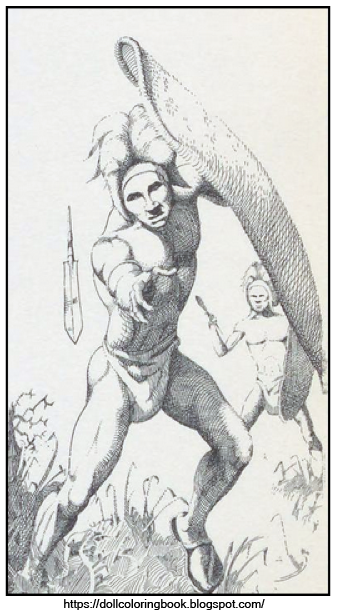Shame enters the family that tills the soil” is a proverb of the Tuaregs of the Sahara. These people look down on all labor except tending and raising camels, for they are caravan people. When they go to the oases or the villages in the mountains of Air, their manners show their scorn of the farming people, though actually the villagers and the nomads could not manage without each other. The villagers furnish food and markets for the nomads, and in turn the desert folk protect the village people and keep them in touch with the country beyond their oasis.
The name Tuareg is an Arabian word meaning “people of the veil,” for the Tuareg men go veiled with only their eyes and foreheads showing. Strangely enough, the women wear no veils although these people are Mohammedans who usually veil their women and keep them in seclusion.
The Tuareg camps are widely scattered, a few huts in one place and farther away a few more. These camel men live where there is grazing for their animals and not far from the water supply. But they never camp next to the well for fear of enemies. In the desert everyone goes to the water, and if an enemy does come in the night his footprints in the sand will give warning of his presence. The wells are never poisoned and no enemy is ever denied water, but strangers are always suspected. In the minds of the nomads there is always fear of a raid, and men around the campfires or on caravan journeys mutter together of the danger. They are ever on the alert.
The Tuaregs hide their camps as much as possible, always remembering to provide a way of escape in case of attack. They may choose a spot near rocky hills or in a dry river-gully. Their huts are small and dome-shaped, like molehills, so that they blend into the landscape. They are simply made of poles tied together, with grass matting or skins thrown over them. Inside is a couch, about a foot high, that almost Tills the hut, and here the whole family sits or lies crowded together. These nomads have few possessions, and those they have are easily moved. If there is a raid, they have little to lose.
Once a year a great caravan crosses the desert to obtain salt, an important article of trade in Africa. Most of the Sahara is too dry for men to live, and the route of this caravan goes through the most arid region. There are few wells. Food for men and camels must be carried, and fodder for the return journey is left at certain spots. All the men of the desert are eager to go on this trip. There may be 7000 camels, four or more abreast, stretching in a great caravan seven miles across the desert.
The departure is as exciting as Christmas day with us. These people have no calendar; the date is decided by the new moon, and all the men and camels gather well in advance of the day. They camp on the side of a river-bed-animals, men, bales of fodder, skins of water everywhere. Only the pick of the animals can go, but, even so, many die by the way, for the hardships are very great. On the trail men rise at three or four in the morning before the sun is up and plod steadily on in cruel sun and heat, two and a
half miles an hour, forty miles a day, never stopping until two hours after sundown.
Camels are always noisy when they are being unloaded, but when they are tired, as they are after the long march, they complain loudly. The roaring of the camels fills the camp, and the noise keeps up far into the night as the end of the long caravan drags slowly into camp. You may wonder why the Tuaregs are willing to undergo such an ordeal. Perhaps it is because everyone knows that only the strong can take the journey.
The Tuaregs are a warlike people, proud and aloof. They dominate the desert, and it is they who have given a romantic glamour to our thoughts of the life of the nomad. Edith Fleming








